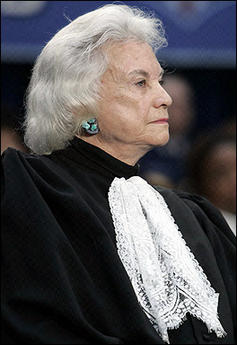Traditionally, the last Monday in June is when the US Supreme Court meets for the final day of its current term. And, because the Court usually issues a flood of decisions on this day, it is invariably fraught with suspense and high drama. Nevertheless, pending decisions in a few controversial cases and, more importantly, the anticipated announcement by Chief Justice William H. Rehnquist of his retirement made the emotions surrounding the end of the Court’s 2004 – 2005 term (Monday 27th) especially acute.
As it turned out, however, neither the decisions nor the Chief Justice provided the legal or emotional catharsis that was so devoutly to be wished. In fact, when the most anticipated rulings on displays of the Ten Commandments and the power of local governments to seize private property were published, they provided more fodder for controversy than resolutions as expected. And, instead of the dramatic announcement of his retirement, Rehnquist gave only a muted stare of resilience (and defiance) to all who waited with bated breath to bid him farewell.
But then last Friday, as conservative and liberal activists were still bickering over the court’s frustrating adjournment, the bombshell announcement that Justice Sandra Day O’Connor had tendered her resignation washed over Washington like a political tsunami. And, without missing a beat, journalists and political pundits transitioned into frenzied speculation and unhinged rhetorical skirmishes over who and, more precisely, what type of judge President Bush would or should nominate as O’Connor’s replacement.
 Justice Sandra Day O’Connor embodied a pragmatic voice on the US Supreme Court that may have been silenced forever with her surprising resignation…
Justice Sandra Day O’Connor embodied a pragmatic voice on the US Supreme Court that may have been silenced forever with her surprising resignation…
Of course, this is hardly the homage, gratitude or eulogy O’Connor would have expected to greet her resignation after almost a quarter century of distinguished service on the US Supreme Court. After all, she was not only the first woman appointed to the Court (notably by Republican President Ronald Regan in 1981), but also the Justice whose political skills for forging majorities amongst her colleagues on some of the most significant cases of our time were unparalleled and unprecedented. Indeed, O’Connor’s legacy will undoubtedly be that of casting deciding votes and drafting majority rulings on controversial issues (covering affirmative action, sexual harassment, abortion and the death penalty) that were both legally sound and politically acceptable.
Yet, it is this very pragmatism (or lack of a predictable ideological philosophy) that makes the nomination process to replace O’Connor’s so potentially combustible. Because conservatives and liberals are equally determined to use all means necessary to ensure that Bush nominates and the Senate confirms a judge on whom they can rely in their ongoing battle for the soul of America. And, neither side seems prepared to settle for a compromise nominee who might follow O’Connor’s sensible, impartial and non-ideological path.
And so, with lines in the battle so clearly drawn and rhetorical salvos already assaulting the public consciousness through TV ads and talking heads, it seems due regard for O’Connor’s legacy has already become the first casualty of this war. Another more ominous casualty, however, is the recently heralded compromise between the White House and centrist Senators that allowed a number of President Bush’s judicial nominees for the Federal Courts of Appeal to be confirmed after years of being stalled by Democratic filibusters.
In fact, rabid conservatives have already voiced visceral opposition to the prospect of Bush nominating his own Attorney General Alberto Gonzalez – a Republican whose credentials they deem too moderate and progressive. And for their part, indignant liberals have already declared the nomination of any conservative judge to replace O’Connor precisely the kind of “extraordinary circumstance” that would trigger a filibuster and, presumably, a “nuclear option” in response by their conservative adversaries.
Therefore, what looms between now and the first week in October – when the Court traditionally begins its new term – is what Harvard Law School Professor Heather Gerken describes as:
…a Capitol Hill blitzkrieg centering on retiring Supreme Court Justice Sandra Day O’Connor’s replacement [that] will be among the most caustic political battles American voters have ever witnessed….What you’ll have is the perfect storm between the already polarized Democrats and Republicans…and they are not in a mood for compromise.
And those poor American GIs in Iraq think they’re the ones fighting for our freedoms…
News and Politics
Leave a Reply
You must be logged in to post a comment.